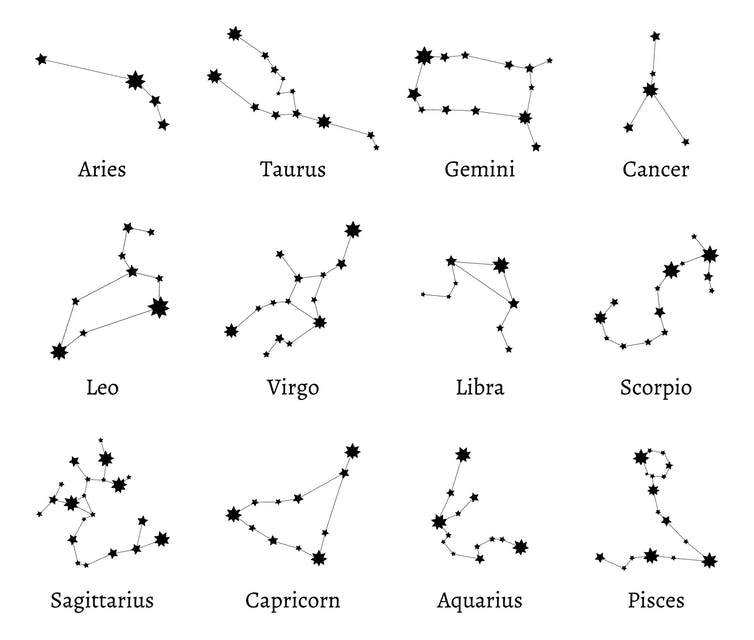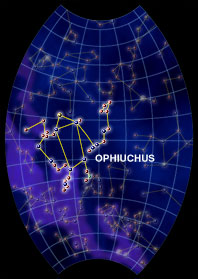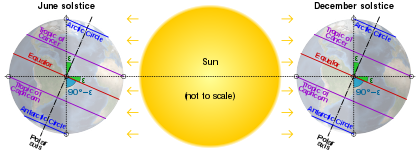.jpg%22&N=Parnassus,_Andrea_Appiani_(1811).jpg)
Apollo and the Muses
This lesson's attendant mythological figure, Apollo, has the dubious distinction of being the most complex of all the Olympians. He has served as the god of music, poetry, prophecy and even the Sun. Here we see him performing on the lyre in the company of the muses, the goddesses that inspired humans in their artistic and intellectual endeavors. The muses were often mistakenly believed to have been Apollo's daughters. Instead, their father Zeus assigned Apollo the daunting task of instructing them in art, music, history and, alas, astronomy.
Depending on the poet one consults, Apollo can appear either sympathetic or malevolent. Despite his divine beauty and potency, he is perhaps best known for his ignominious failures to pursue women. He once famously chased the reluctant Daphne who preferred to be transformed into a tree rather than allow Apollo to capture her. In another tale, Apollo promised the beautiful woman Cassandra the gift of prophecy in exchange for carnal favors. She agreed, but after having received the gift, Cassandra refused to submit. Although the enraged Apollo could not withdraw the gift, he did smite her with a nasty curse. While she retained her prophetic powers, Apollo made sure that nobody would believe her prophecies.
Even today the name "Cassandra" is applied to those whose correct predictions about the future have gone unheeded.
THE SOUTHWORTH PLANETARIUM
207-780-4249 www.usm.maine.edu/planet
70 Falmouth Street Portland, Maine 04103
43.6667° N 70.2667° W
Altitude: 10 feet below sea level
Founded January 1970
Julian Date: 245941.16
Julian Date: 245941.16
2019-2020: CXVII
"Heavens on the half shell"
THE DAILY ASTRONOMER
Wednesday, April 1, 2020
Remote Planetarium 3: Gliding Along the Zodiac
Yesterday we imposed our all too human constructs onto the otherwise unblemished sky. Our aim is to develop a grid work enabling us to systematically study the Universe. That aim is, after all, astronomy's principal mission.
We devised three main constructs:
-The Celestial Equator: the projection of Earth's equator onto the sky. Were it a real line, it would extend between due east and due west and would be visible from every location on the planet. For an equatorial observer it would pass directly overhead. For an observer at the north pole or south pole, it would be aligned with the horizon. For a northern hemisphere observer, the celestial equator's maximum angle would be above the due south point and would equal 90 - the observer's latitude. Portland, Maine's latitude is approximately 43 degrees north and so the celestial equator passes 90 - 43 = 47 degrees above due south.
-The Meridian: the line connecting due north and due south. This meridian is specific to the observer's location. Your meridian is not the same as mine unless we were both standing precisely on the same longitude line.
-The Ecliptic: the undulating path the Sun follows throughout the year. For us northern hemisphere observers, it attains its maximum altitude of 23.5 degrees north of the celestial equator on the June solstice and a minimum altitude of 23.5 degrees south of the celestial equator on the December solstice.
[One would say that the Sun's summer solstice declination is 23.5 degrees and its winter solstice declination is -23.5 degrees.]
Today we explore the Zodiac, the retinue of thirteen constellation regions through which the Sun travels each year. These constellations are aligned along the ecliptic. We should mention that some astronomers become slightly sniffy whenever we employ the term "zodiac," as it smacks of astrology, the ancient mystical practice of using celestial objects to predict the future and determine a person's predominant personality traits. What can we say in our defense except that,well, every single symbol astronomers use for the planets and the constellations, themselves, all derive from astrology. The sniffy astronomers tend to forget, or at least refuse to acknowledge, that astronomy arose from astrology much as chemistry was borne out of alchemy. Therefore, we'll employ the term "zodiac" despite the consequent damnation of our immortal souls.
The Zodiac is immensely important to night sky observations because it is within the band around it that one will find the moon and planets. An Earthbound observer will never find Venus next to Orion's knee or the crescent moon resting in the Big Dipper's bowl. (Too bad! That sight would be fantastic!)
We provide a list of the Zodiac constellations. Next to each constellation is the time period in which the Sun appears to be moving through it.
Pisces the Fish [March 12 - April 18]
Aries the Ram [April 19 - May 13]
Taurus the Bull [May 14 - June 21]
Gemini the Twins [June 22 - July 20]
Cancer the Crab [July 21 - August 10]
Leo the Lion [August 11 - September 15]
Leo the Lion [August 11 - September 15]
Virgo the Maiden [September 16 - October 30]
Libra the Scales [October 31 - November 22]
Scorpius the Scorpion [November 23 - November 29]
Ophiuchus the Serpent Charmer [November 30 - December 17]
Sagittarius the Archer [December 18 - January 18]
Capricornus the Seagoat [January 19 - February 15]
Aquarius the Water Bearer [February 16 - March 11]


We see the thirteen constellations pictured above. Notice that we had to steal a different image for Ophiuchus as it is the oft-neglected zodiac constellation, one that astrologers tend not to recognize.
We would like to call your attention to a few matters related to the zodiac.
First, the night sky is divided into eighty-eight rectilinear regions named for the each of the eighty eight constellations officially designated by the International Astronomical Union. The dates listed above pertain to the dates when the Sun appears to be within the region defined by the associated constellation.
Secondly, the astrological zodiac is much neater and more fair to the twelve constellations contained within it. The astrological zodiac places the Sun in each constellation for approximately 30 days. The astronomical zodiac is not as proportionate. For instance, the Sun requires 45 days to "travel" through Virgo, but only nine days to traverse the Scorpius region.
Thirdly, the dates we listed might be confusing if you read newspaper horoscopes. The astrological dates are different from the astronomical ones because the astrological zodiac refers to a 2000 year old calendar. Yes, that does matter because these dates slowly change over time due to precession, the wobbling of Earth's axis. This wobbling causes the sun's position along the zodiac to shift by about one degree every 73 years. The Sun used to be in Aries on the vernal equinox. Now, it is located in Pisces, but is slowly moving. In the late 26th century, the Sun's vernal equinox position will shift into Aquarius.
Finally, the Zodiac constellation club is very exclusive. It doesn't permit new members. Once a zodiac constellation, always a zodiac constellation. If a constellation is outside the zodiac, it will never work its way into it.*
To understand why the Sun appears to "move through" constellations we must hoist ourselves up into outer space and observe how Earth moves relative to the Sun and stars. Earth revolves around the Sun and completes one orbit every year. As Earth moves, the Sun appears to move through different constellations because of Earth's changing position relative to it. The graphic below shows the Sun between Earth and the stars comprising Taurus the Bull. At this time, the Sun blocks our view of Taurus and therefore is appearing to move "through it."

We next note that Earth is tilted on its axis by 23. 5 degrees from the vertical. This orientation explains the ecliptic's undulations. On the June solstice, the northern hemisphere is aligned as closely toward the Sun as possible. At this time the Sun is 23.5 degrees north of the celestial equator. (Yes, that angle is equal to Earth's tilt.) On the December solstice, the northern hemisphere is pointed as far away from the Sun as possible. At that time, the Sun is 23.5 degrees south of the celestial equator.

The Zodiac is so important to observational astronomy because the moon and the planets, save Pluto, appear to travel quite close to it. They do so because the solar system is disc-shaped and the planes of the moon's orbit and that of the other planets are closely aligned with Earth's orbital plane, which we naturally call the ecliptic.
As we proceed through our study of solar system bodies we will find ourselves returning quite often to this retinue of thirteen constellations through which the Sun travels.
Tomorrow, we visit the closest of all celestial bodies, the moon.
*We should mention that constellations do change as a consequence of proper stellar motions. Over the courses of hundreds of thousands of years, the constellation patterns will dissipate. However, over the "short term," always a funny phrase in astronomy, the zodiac constellations will remain the same.
To subscribe or unsubscribe from the Daily Astronomer: